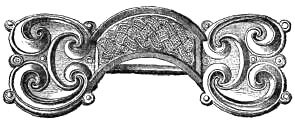Henry II. in Ireland

Ancient Irish Brooch[6]
Arrival of Henry II.—Some of the Native Princes pay him Homage—His Character—Dublin in the time of Henry II.—His Winter Palace—Norman Luxuries—King Henry holds a Court—Adrian's Bull—Temporal Power of the Popes in the Middle Ages—Conduct of the Clergy—Irish Property given to English Settlers—Henry II. returns to England—The Account Cambrensis gives of the Injuries done to Ireland by his Countrymen—Raymond, Montmarisco, and Strongbow—The latter is defeated—He recalls Raymond from Wales—Treaty between Roderic and Henry—Death of Strongbow.
[A.D. 1171—1176.]

ENRY landed in Ireland on the 18th of October, 1171, at Crook, in the county of Waterford. He was accompanied by Strongbow, William FitzAldelm, Humphrey de Bohun, Hugh de Lacy, Robert FitzBarnard, and many other lords. His whole force, which, according to the most authentic English accounts, was distributed in four hundred ships, consisted of 500 knights and 4,000 men-at-arms. It would appear the Irish had not the least idea that he intended to claim the kingdom as his own, and rather looked upon him as a powerful potentate who had come to assist the native administration of justice. Even had they suspected his real object, no opposition might have been made to it. The nation had suffered much from domestic dissension; it had yet to learn that foreign oppression was an incomparable greater evil. If a righteous king or a wise statesman had taken the affair in hand, Ireland might have been made an integral and most valuable portion of the British Empire without a struggle. The nation would have bowed gratefully to an impartial government; they have not yet ceased to resent a partial and frequently unjust rule. From the very commencement, the aggrandizement of the individual, and not the advantage of the people, has been the rule of action. Such government is equally disgraceful to the rulers, and cruel to the governed.
Notes
[6] Irish Brooch.—The brooch figured above is of great antiquity. It was found in the Ardkillen crannoge, near Strokestown, county Roscommon. The original is in the Royal Irish Academy, and is considered the finest specimen of bronze workmanship in the collection.
